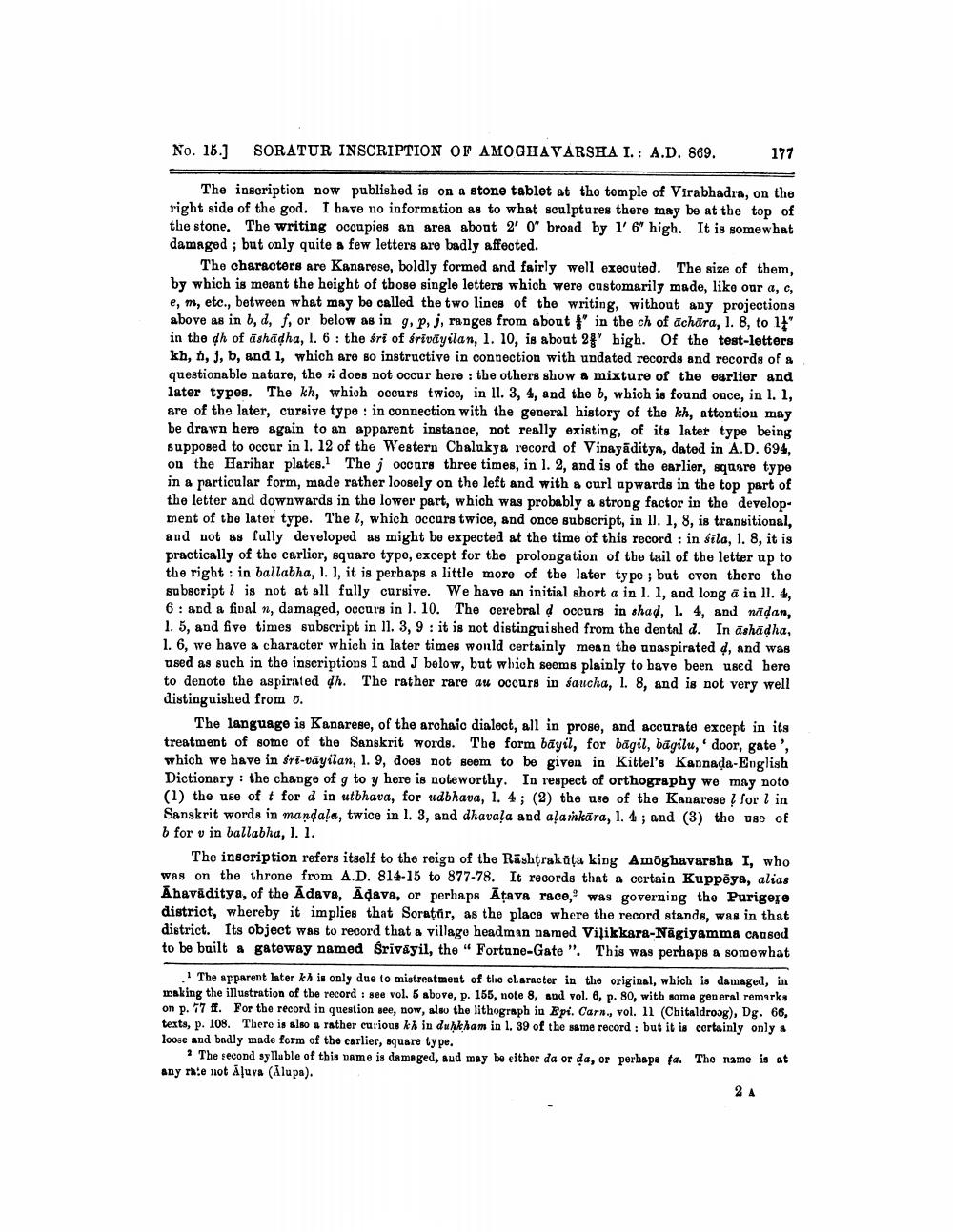________________
No. 15.]
SORATUR INSCRIPTION OF AMOGHAVARSHA I.: A.D. 869.
The inscription now published is on a stone tablet at the temple of Virabhadra, on the right side of the god. I have no information as to what sculptures there may be at the top of the stone. The writing occupies an area about 2' 0" broad by 1' 6" high. It is somewhat damaged; but only quite a few letters are badly affected.
177
The characters are Kanarese, boldly formed and fairly well executed. The size of them, by which is meant the height of those single letters which were customarily made, like our a, c, e, m, etc., between what may be called the two lines of the writing, without any projections above as in b, d, f, or below as in g, P, j, ranges from about " in the ch of achara, 1. 8, to 11" in the dh of ashadha, 1. 6: the śri of śriväyilan, 1. 10, is about 28" high. Of the test-letters kh, i, j, b, and 1, which are so instructive in connection with undated records and records of a questionable nature, the r does not occur here: the others show a mixture of the earlier and later types. The kh, which occurs twice, in 11. 3, 4, and the b, which is found once, in 1. 1, are of the later, cursive type: in connection with the general history of the kh, attention may be drawn here again to an apparent instance, not really existing, of its later type being supposed to occur in 1. 12 of the Western Chalukya record of Vinayaditya, dated in A.D. 694, on the Harihar plates. The j occurs three times, in 1. 2, and is of the earlier, square type in a particular form, made rather loosely on the left and with a curl upwards in the top part of the letter and downwards in the lower part, which was probably a strong factor in the development of the later type. The l, which occurs twice, and once subscript, in 11. 1, 8, is transitional, and not as fully developed as might be expected at the time of this record: in sila, 1. 8, it is practically of the earlier, square type, except for the prolongation of the tail of the letter up to the right in ballabha, 1. 1, it is perhaps a little more of the later type; but even there the subscript is not at all fully cursive. We have an initial short a in 1. 1, and long a in 11. 4, 6 and a final n, damaged, occurs in 1. 10. The cerebral d occurs in shad, 1. 4, and naḍan, 1. 5, and five times subscript in 11. 3, 9: it is not distinguished from the dental d. In ashaḍha, 1. 6, we have a character which in later times would certainly mean the unaspirated 4, and was used as such in the inscriptions I and J below, but which seems plainly to have been used here to denote the aspirated dh. The rather rare au occurs in saucha, 1. 8, and is not very well distinguished from ö.
The language is Kanarese, of the archaic dialect, all in prose, and accurate except in its treatment of some of the Sanskrit words. The form bayil, for bagil, bagilu,' door, gate', which we have in fri-vayilan, 1. 9, does not seem to be given in Kittel's Kannada-English Dictionary: the change of g to y here is noteworthy. In respect of orthography we may noto (1) the use of t for d in utbhava, for udbhava, 1. 4; (2) the use of the Kanarese for in Sanskrit words in mandala, twice in 1. 3, and dhavala and alamkara, 1. 4; and (3) the use of b for v in ballabha, 1. 1.
The inscription refers itself to the reign of the Rashtrakuta king Amoghavarsha I, who was on the throne from A.D. 814-15 to 877-78. It records that a certain Kuppeya, alias Ahavaditya, of the Adava, Aḍava, or perhaps Aṭava race, was governing the Purigere district, whereby it implies that Soratur, as the place where the record stands, was in that district. Its object was to record that a village headman named Vilikkara-Nagiyamma caused to be built a gateway named Śrivayil, the " Fortune-Gate". This was perhaps a somewhat
1 The apparent later kh is only due to mistreatment of the character in the original, which is damaged, in making the illustration of the record: see vol. 5 above, p. 155, note 8, and vol. 6, p. 80, with some general remarks on p. 77 ff. For the record in question see, now, also the lithograph in Epi. Carn., vol. 11 (Chitaldroog), Dg. 66, texts, p. 108. There is also a rather curious kh in duḥkham in 1. 39 of the same record: but it is certainly only a loose and badly made form of the earlier, square type.
2 The second syllable of this name is damaged, aud may be either da or da, or perhaps fa. The name is at any rate not Aluva (Alupa). 2 A




